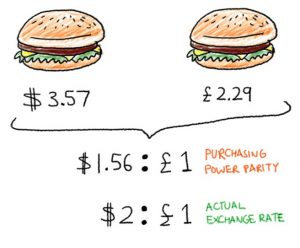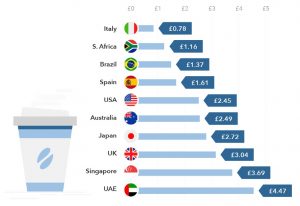Introduction:
The purpose of this assignment is to explain a technical term of our choice using technical writing skills to a target audience with little or no experience in a related field. We are required to explain the term in parenthetical, sentence, expanded format. This assignment allows us to practice using technical words and phrases to explain difficult concepts to the non-technical audience related to our professional field. The term that I am going to explain is Purchasing Power Parity.
Term:
Purchasing Power Parity
Parenthetical Definition:
Purchasing Power Parity (currency measurement through a “basket of goods” approach) is arguably a more accurate measure than the exchange rate to compare consumer’s purchasing power in different places.
Sentence Definition:
Purchasing Power Parity is an economic theory of exchange rate determination to reflect economic productivity and standard of living in a country. It shows the amount of each currency needed to buy similar goods.
Expanded Definition:
History
The concept of Purchasing Power Parity is originated from a Swedish Economist, Gustav Cassel, in 1918. Cassel asserted about a new theory that he created: The Law of One Price, which means that the cost of similar goods will be the same when the prices are expressed in the same currency in different markets.
Compare and contrast
Purchasing Power Parity is not the same as the exchange rate.
The exchange rate purely measures the movement of two currencies according to market demand and supply. The prices of non-traded goods are not taken into account, which leads to inaccuracy of the exchange rate while measuring living standards.
Purchasing Power Parity is measuring currencies by observing a basket of goods. Through the cost of goods could the economist understand the real price level in the market that consumers are facing in their everyday life, which is arguably a closer estimate than the exchange rate.
Visual
Figure 1 explains Purchasing Power Parity. A burger costs $3.57 in the US, while the same burger costs £2.29 in the UK. This means that, in the same market, the cost of goods should always maintain a ratio of $1.56 against £1 of goods. However, as per the image, the actual exchange rate reflects a wider ratio comparing two currencies, which shows discrepancies in pure currency comparison and cost of goods. (Wilson and Li, 2020)
The comparison of the cost of burgers (i.e. the Big Mac Index) has been used every year by all countries to measure Purchasing Power Parity and GDP in terms of a basket of goods.
Figure 1

Figure 2 shows the cost of the same cup of coffee in different countries. It costs the cheapest in Italy, which is only £0.78, whereas in UAE it costs £4.47, which is the most expensive in the world comparatively. The discrepancy occurs because the purchasing power is different in these countries. The aim of Purchasing Power Parity is to make a comparison between currencies to be more valid by adjusting local purchasing power differences. (IG Bank, 2020)
Figure 2 (IG bank 2020)

Required Conditions
In order to accurately show the Purchasing Power Parity, there are several required conditions. First, countries need to include a wide variety of goods in order to generalize the cost of goods to the average level. They also have to measure the same basket of goods in order to get the correct currency comparison.
Purchasing Power Parity also requires exclusion of tax calculation. Different countries have a different practice of tax payment; some are customer-transferrable (e.g. sales tax) some are non-customer-transferrable (e.g. import tax); some require expensive tax payment, but some do not. In order to generalize a fair result, the tax should be excluded in the calculation.
Sources:
Purchasing Power Parity – Learn How to Construct and Use PPP. (2019, December 10). Retrieved from https://corporatefinanceinstitute.com/resources/knowledge/economics/purchasing-power-parity/
IG Bank, (2020). What Is Purchasing Power Parity (PPP) Retrieved from: https://www.ig.com/en-ch/trading-strategies/what-is-purchasing-power-parity–ppp—191106
Robinhood, (2020). What Is Purchasing Power Parity (PPP). Retrieved from: https://learn.robinhood.com/articles/7zujPxSG6V3QxlONIy2MrU/what-is-purchasing-power-parity-ppp/ [Accessed 4 June 2020].
Rogoff, K, (1996). The Purchasing Power Parity Puzzle. Journal of Economic Literature. 34, 647-668. https://scholar.harvard.edu/files/rogoff/files/51_jel1996.pdf
Wilson, F. and Li, J., (2020). Purchasing Power Parity – MBA Mondays Illustrated. MBA Mondays Illustrated. Retrieved from: https://mba-mondays-illustrated.com/2014/04/purchasing-power-parity/
Leave a Reply